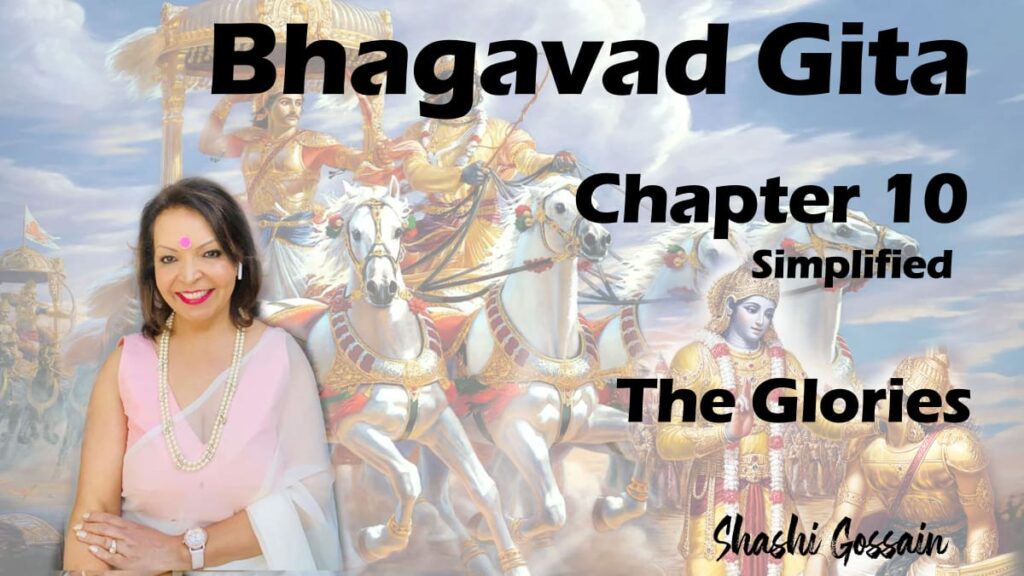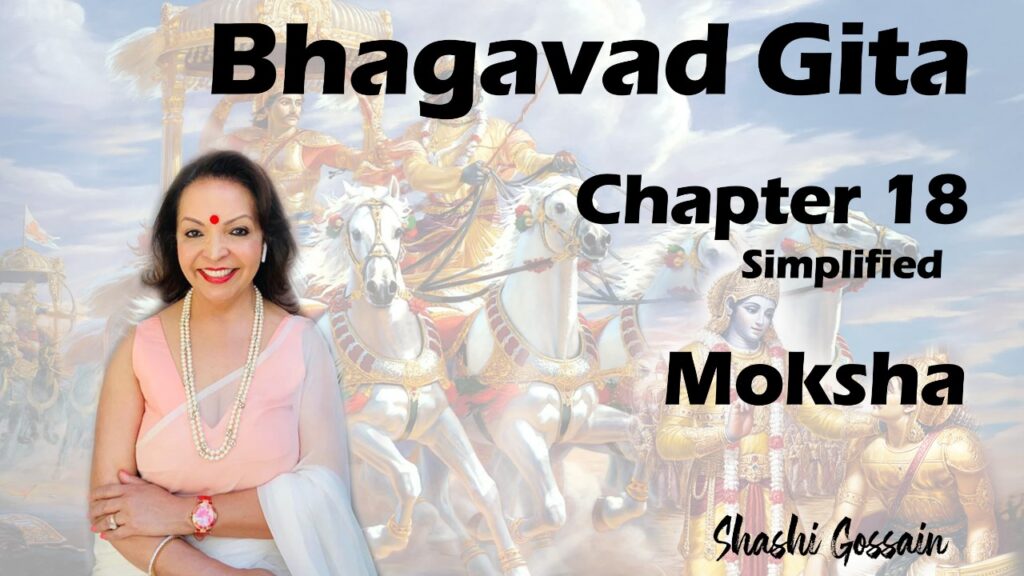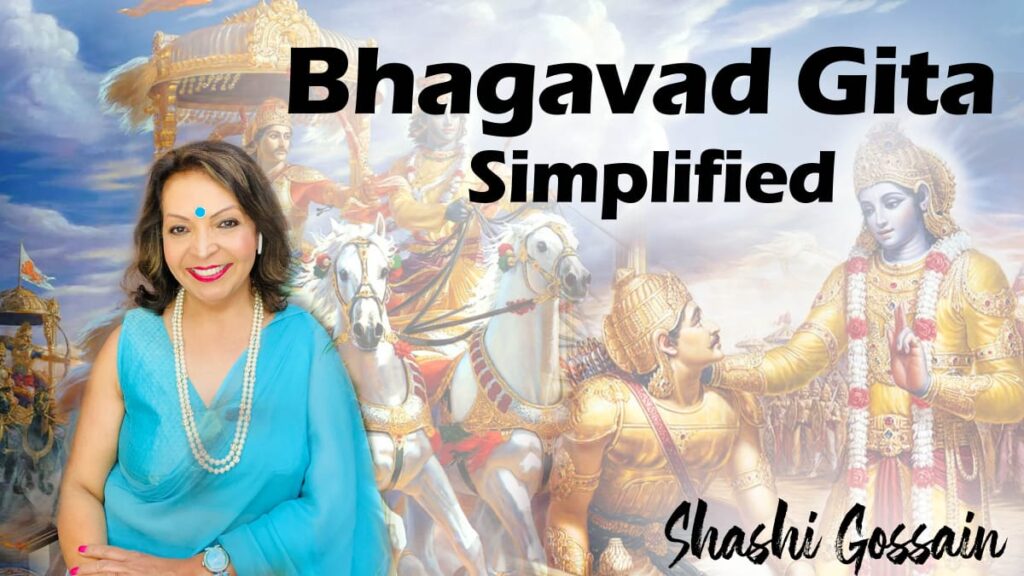In the previous chapters, Lord Krishnarevealed God as the material cause of the universe. Since this leads to an effect, it follows that the entire universe is the divine manifestation of God.
Who is God (Bhagwan) according to Geeta? Why is Krishna considered a hero God?
Bhagavan, the Divinity, is the name used for Krishna throughout the Gita. Bhagavan means one who has bhaga, the six aspects of fullness, or the six absolute virtues. They are Riches, Strength, Fame, Beauty, Knowledge, Renunciation. Bhagavan is the original source, in all Forms, Manifestations, Creations. It remains unmoved amidst the impermanence. Arjun has now realized Krishna’s position as the Absolute Truth. At this point, Arjun is totally enthralled in Shri Krishna’s teachings. Shri Krishna continues by listing his attributes, as the vastness of Ishvara’s power is still incomprehensible, invisible & unknown to our senses. No one can talk about Ishvara except Ishvara himself. He’s the ultimate cause. Everything else, the effect, came after him. All deitis, rishis & sages have come after Ishvara, so cannot even begin to know the eternal. Shri Krishnaji says that the end result of devotion is reached when one understands Ishvara as the Lord of the Universe, and has the capacity to discriminate between real & unreal. To give an analogy, every country has a national flag, the national anthem, Independence Day, or a national emblem that represents the country. Similarly, Shri Krishna starts giving examples of attributes as examples of Ishvara and his manifestations. So when we see that Ishvara is present everywhere and all the time, beyond the realm of time and space, we automatically begin to understand that everything else is finite and transient. Our reactions to situations become calmer. Shri Krishnaji then goes onto describe the expressions of Ishvara:
- Intelligence
- Wisdom
- Non-delusion
- Forgiveness
- Self-restraint
- Joy and sorrow
- Creation and destruction
- Fear and fearlessness
Whenever we come across any of these expressions, we should immediately realize that it is Ishvara expressing himself through them. Shri Krishna wants us to remain equal, & remain balanced in all aspects. Ishvara may send a sorrowful situation. He may destroy a person, object or situation so that a new one can be created in its place. It’s just a cycle of events. Shri Krishna continues with more expressions that are generated in us by Ishvara:
- Non-injury (ahimsa):not hurting physically or mentally
- Equanimity (samataa): de-attach from joy/sorrow
- Contentment (tushtihi): accept everything in life as a gift from Ishvara
- Penance (tapaha): energy stored up in our body when we practise restraint
- Charity (daanam): donating time or wealth
- Fame (yasha): comes through pursuit of dharma
It is our karma or actions that determine which qualities or states will arise within us. Shri Krishna then goes on to describe the visible expressions.
Who created the universe? Who is the father of Manu?
As documented in the scriptures, the entire universe was created by
- Seven great sages &
- Fourteen individuals known as “Manus”.
Shri Krishna asserts that these sages and Manus were themselves created by Ishvara through his mind. Ishvara first created Lord Brahma and entrusted him with the responsibility of creating the universe.
Who are the sons of Lord Brahma?
Lord Brahma had four sons:
- Sanaka
- Sanandana
- Sanaatana
- Sanatkumaara.
When he asked them to populate the world, they refused, because they did not want to get tangled in any material pursuits. They took the vow of celibacy and roamed the world, constantly contemplating upon Ishvara. Next, Lord Brahma created the saptarishis or the seven great sages Bhrigu, Marichi, Atri, Pulastya, Pulaha, Kratuhu and Vasishtha. He then created Manu for further procreation and establishment of the moral code, which is known as Manusmriti. So Ishvara was the cause of all creation. They were created from his mind. One who can understand all the expressions, gets an unshakeable connection with Ishvara. This is called “avikampa yoga” or yoga of unwavering devotion. One will only experience sorrow when one forgets that Ishvara is the cause of everything. The key here is to develop a vision that goes into the essence of any object or person or situation instead of getting distracted by the physical shape or form. We will take every situation as a learning experience and keep our focus on Ishvara. Like musicians who eat, sleep, breathe and talk about music, the devotee’s converse & educate each other about Ishvara, and dedicate their mind and senses to Ishvara. Ishvara rewards his ardent devotees with the highest type of blessing, which is intellectual. No object, wealth, social status or possession can stand in front of the knowledge of the true nature of things.
How Lord Krishna protects his devotees?
Ishvara takes care of his devotees. He will ensure:
- All material needs are provided for
- ignorance is destroyed
- spiritually educated
There is no need to recite mantras on rosary beads or sit in any postures. All that is required is acceptance and surrender. Arjun now understood the real nature of Ishvara, as an avatara, a divine manifestation of Ishvara, the absolute reality & eternal essence. Renowned sages Naarada, Asita, Devalaha and Vyaasa had also realized this Arjun recognises Ishvara is the Lord of the Universe. That Ishvara is the cause, and the magic show of the universe is the effect.
Arjun goes on to ask, which form does he meditate upon?
He requested Shri Krishna to give a detailed description of-
- Ishvara’s expressions and
- The power of Maaya creates so many expressions of the one Ishvara.
Shri Krishna admitted that though it would not be possible to list all of Ishvara’s glories and expressions because they are infinite. However, he would be able to list the most significant ones. Shri Krishna begins to describe 72 expressions, starting with 2 main ones: Ishvara is the:
- “I” in every living matter
- Start, middle & end of all beings in the universe, meaning Ishavar is present in every atom.
Practically, there will be nothing in us that asserts “my will”, “my plan”, “my thinking”, “I am going to do this” and so on. It will all become Ishvara’s will, Ishvara’s plan, Ishvara’s thinking, Ishvara’s doing. All worries and anxieties will disappear because the “I”, is no longer present. Ishvara is the “I” in us. Krishnaji carries on listing Ishvara’s expressions. He is:
- Lord Vishnu
- The Sun
- The Wind
- The Moon
With these expressions in our mind, we will never be disconnected from Ishvara. In the day, we can look at the sun;it is Ishvara. When the winds blow, it is Ishvara. In the night, the moon is Ishvara.
- The Music in Saama Veda
- King of deities, serving all devotees
- Mind that controls all our senses & limbs
- Intelligence in Humans
So therefore, if our mind generates thoughts of compassion or service, if our intellect makes us acts upon these thoughts so that we can serve others, we should remember that it is not the “I” in us that is causing everything to happen. It is all happening through Ishvara and his expressions
- Lord Shiva represents the vital life energies & joy.
- Kubera, the Lord of wealth.
- Vedic Fire, the purifier
- Mount Meru, the central, most prominent peak of the Himalayas. It’s the centre of the spiritual universe
Whenever we see fire, mountains, wealth, or someone in sorrow due to punishment, we should remember Ishvara through his expressions of fire, Kubera, Mount Meru and Lord Shiva.
- Brihaspati: foremost spiritual teacher of the deities
- Skanda: the most powerful celestial army commander
- Ocean: sustains life on earth & is home of thousands of species.
With this in mind, we should be able to see Ishvara in our teachers, military prowess, and when we drink water.
- Sage Bhrigu: foremost among great sages, who was created by Lord Brahma
- Om: the sacred one word syllable, that can lead to liberation
- Japa: act of chanting mantras, which can be done by everyone, everywhere
- Himalayas: highest and most massive mountain system in the world.
Shri Krishna says that among the immobile objects in the world, the Himalayas are the most prominent manifestation of Ishvara. Elaborating upon Ishvara’s expressions, Shri Krishna says, Ishvara is:
- Peepul tree, the most sacred. Trees are considered like saints, as they give back more than they take.
- Sage Narada: travelling celestial who carries news & wisdom
- Chitraratha: the foremost celestial musicians
- Kapila: a superhuman sage, or siddhi, who was enlightened & liberated
So whenever we see music, dance, singers, and all the nature around us, we should remember that all these are Ishvara’s expressions.
- Ucchaihshrava: a divine horse, but symbolically, stands for the prosperity
- Airaavata: a divine elephant, who was the mount for Lord Indra, the king of the deities.
- Leader: who through their hard work & effort & with dharma, accomplish great projects?
So whenever we see the result of hard work, a humanitarian leader, or the cooling rain that parches a dry land, we should remember that all these are Ishvara’s expressions.
- Vajra: the scared thunderbolt weapon of Lord Indra, which was made of bones of sage Dadhichi.
- Kaamadhenu: the sacred cow that has the ability to fulfil any desire.
- Kandarpa is Lord Kaama, the god of desire. Desire leads to creativity, which is needed for new creations. Gita does not condemn desires, if it used in the right way to create something useful.
- Vasuki: the snake coiled around Lord Shiva., symbolising taming of the ego.
So whenever we see someone devote their life towards a selfless cause, when our mind generates positive thoughts, when our desires are righteous and our ego is in check, we should realize that all this is Ishvara’s expression.
- Ananta: a water snake, depicted with a thousand heads, with Lord Vishnu.
- Lord Varun: the king of the seas, that holds all the marine life.
- Aryama: the foremost ancestor God that lives in heaven.
- Lord Yama: Lord of final justice, who passes the final judgement to maintain order and harmony in the universe.
Shri Krishna continues:
- Wind: is the foremost expression of purification. Deep inhalation and exhalation removes several toxins from the body.
- Lord Raama: the foremost wielder of weapons. He only used weapons as a last resort when no other methods of diplomacy worked.
- Makara: a giant whale, a powerful sea creature
- River Ganga: symbolically, knowledge, just like the river Gangaa, always flows from a higher plane to a lower plane. Knowledge purifies, just like a river purifies.
So whenever we feel the wind, when we see weapons used justly, when we behold the giant whale or the mighty river, we should know that all these are Ishvara’s manifestations. So as not to get stuck in analogies, Shri Krishna reiterates that Ishvara is in everything and at all times.
- As Brahma: he creates the universe
- As Vishnu: he sustains the universe
- As Shiva: he dissolves the universe.
But Ishvara is ever present, he is the guiding force.
Next, he refers to Ishvara as the
- Spiritual Knowledge”, There are many types of knowledge e.g. academic or arts knowledge. However, spiritual knowledge, knowledge of our own self, has the power to take us out of the material world and towards Ishvara.
- Vaada” is a debate where both speakers listen to each other, and encourage the most logical argument prevails. It’s not the type where not one or the other speaker wins.
- Such a debate that places logic above ego is Ishvara’s foremost expression. He says he is:
- The letter “a”, the most important letter of the alphabet. It forms the basis of the written language.
- “Dvandva” in Sanskrit grammar. This is the state when two words are joined together, with equal importance to each. It maintains sameness between two objects.
- Infinite Time: prevalent before, during & after creation.
- He “faces all directions”, meaning he ensures that everyone gets exactly what they deserve. He controls prakriti, who is provider of the fruit of everyone’s actions.
So whenever we read literature in both prose and poetry form, or when we contemplate the results of our actions, we should always realize that it is Ishvara working through all of them.
We continue with the descriptions of Ishvara.
- Death: force that destroys things. He is the ultimate destroyer. Death is associated with time, and in the course of time, everything is destroyed.
In the Puranaas, Lord Shiva commences the act of dissolution by performing a dance called “taandava nritya”, with his drum called “damru” in hand.
After dissolution is complete, Ishvara then emerges as the creative principle to begin the next round of creation. Ishvara is the “all matter” of the universe, as well as the energy pervading it. Since some of these manifestations may be difficult for us to follow, Shri Krishnaji goes on to give more tangible examples: These qualities are in the form of Sanskrit feminine nouns:
- Keerti: name and fame on account of performing virtuous deeds
- Shree: beauty and wealth
- Vaak: refined speech
- Smiriti: memory of events
- Medhaa: ability to retain information that was read
- Dhriti: fortitude in the face of exhaustion
- Kshama: forgiveness in the face of sorrow.
Shri Krishna says that Ishvara manifests himself as one or all of these qualities in people. Further manifestations are followed:
- Brihat-Saama: the most powerful mantra in Saama veda mantras.
- Gayatri Mantra: considered the root & essence of all Vedic mantras.
- Maargasheersha: the most auspicious month, which ends in the festival of Makara Sankranti?
- Kusumaakara: Sping season: flower bearing & start of new vegetation.
Both these months are not too hot or cold, leading to calmness & serene minds.
Further descriptions are:
- Gambling: strongest form of maaya. It’s addictive with greatest attachment and ultimately results in great sorrow. Once we are detached from winning or losing, we have overcome maya.
- Splendour in the brilliant: the sharp intellectin such luminaries e.g. Nobel prize winners, freedom fighters, scientists etc, who are focused and victorious.
- Sattva: one of the qualities of nature is the one that gives perfect harmony. Ishvara manifests as this sattva in people who demonstrate virtues such as modesty, calmness, sobriety and goodness.
Shri Krisna then describes Ishvara through examples of people:
- Vrishni: who is part of the Chandravanshis, the Lunar dynasty
- Ushana, or Shukraachaarya: foremost guru or teacher. He could see the future & also had the ability to revive the dead.
- Arjuna: the seeker &
- Vyaasa: the sage who wrote the Mahabharata & other scriptures.
Shri krshna says he’s Arjuna & Vyaasa, because both were divine manifestations, without both of them, the Updesh could not be documented.
His further manifestations:
- Punishment: we need to restrain or subdue our senses; otherwise it would lead to chaotic behaviour. For those who do unlawful conduct due to over indulging the senses, punishment in the form of sorrow is given.
- Strategy: the most important attribute to seekers of victory. Strategy enables us to devise a plan to deal with difficult people & situations.
- Silence: is a rare quality, but imperative for a peaceful conduct. In an angry exchange of words, harsh curses & secrets could be divulged, which can cause great problems. Ishvara is silence himself in the wise.
Having provided a long list of Ishvara’s divine expressions, he now gives us a simple formula to recognize him. He says that whatever we come across in the world, whether it is a living or a non-living entity, or whether it is moving or stationary, it has arisen from the seed that is Ishvara. In other words, Ishvara is the cause of everything in this universe. As we have seen so far, he has highlighted the most glorious & powerful aspects of his creation. However, he admits that it is next to impossible to list every single aspect of creation, but stresses that every single aspect of creation is divine, since it has sprung out of Ishvara himself. Shri Krishna gives us a simple suggestion of how to connect with Ishvara. He says that anything that appeals to our mind and senses, any object or person that is endowed with grandeur, perfection, knowledge and power, anything that inspire a wonderment, that is Ishvara’s expression. So we are free to choose anything that meets these criteria. We can see wonderment all around us e.g:
- Iconic buildings like Taj Mahal, Empire State Building
- Himalayas or the Grand Canyon
- Classical music e.g. Bhimsen Joshi oe Beethoven’s symphony
- Double decker aeroplane or The Space shuttle
- Classical Indian dancer or Ballet
The list is endless… but they are all manifestations of Ishvara & his divine gift. Whenever we see something wonderful and glorious, we should remember that the glory is coming from Ishvara, not from that object or person. Next, we should remember that Ishvara is infinitely more powerful and glorious than the object or person. In this manner, we will be able to maintain a constant awareness of Ishvara. So in conclusion, how do these expressions benefit us? Just like we use symbols of countries to constantly invoke the notion of the country, we should use one or some or all of these expressions to constantly remember and think of Ishvara.




Pingback: Bhagavad geeta Chapter 11: The Cosmic Form - Simple Hinduism
Pingback: Bhagavad Gita Chapter 12: The Devotion - Simple Hinduism